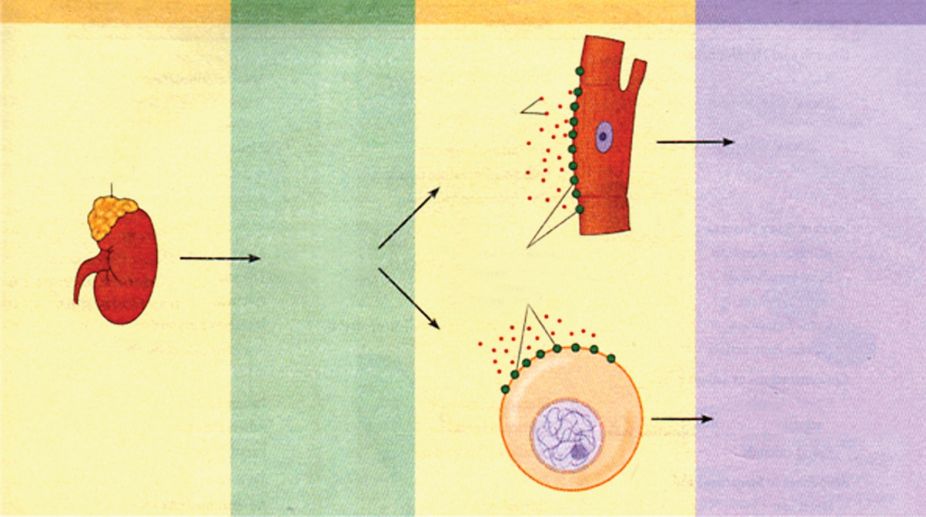To regulate the function of various cells and tissues, both plants and animals use chemical signals called hormones. Hormones are chemical messengers secreted by one tissue that regulate the function of other cells or tissues in the same organism.
In contrast to growth factors, hormones often act over large distances. In plants and animals, hormones are often transported via the vasculature.
Advertisement
Hundreds of different hormones regulate a wide variety of functions, many critical for maintaining the physiological steady state of an organism.
Though it can consider them as a group based on their regulatory functions, hormones differ in many ways. Some hormones are steroids or other hydrophobic molecules that are targeted to intracellular receptors.
Others, such as adrenergic hormones, are targeted to a wide variety of different G protein-linked receptors.
Both plants and animals produce a wide array of hormones. For example, plants produce steroid hormones called brassinosteroids that regulate leaf growth.
Similarly, the organic molecule ethylene regulates ripening of fruit, and abscisic acid causes the closing of stomata during drought conditions.
Hormonal signals can be classified by the distance they travel to their target cells. Even animal hormones can be placed in one of two categories depending on the distance over which it operates.
An endocrine hormone travels by means of the circulatory system from the cells where it is released to other cells, where it regulates one or more specific functions. A paracrine hormone is a more local signal that is taken up, destroyed, or immobilised so rapidly that it can act only on cells in the immediate environment.
Endocrine hormones are synthesised by the endocrine tissues of the body and are secreted directly into the bloodstream. Once secreted into the circulatory system, endocrine hormones have a limited life span, ranging from a few seconds for epinephrine (a product of the adrenal gland) to many hours for insulin.
As they circulate in the bloodstream, hormone molecules come into contact with receptors in tissues throughout the body. A tissue that is specifically affected by a particular hormone is called a target tissue for that hormone.
For example, the heart and the liver are target tissues for epinephrine, whereas the liver and skeletal muscles are targets for insulin.
Hormones regulate a wide range of physiological functions, including growth and development, rates of body processes, concentrations of substances, and responses to stress and injury.
For example in humans, somatotropin is involved in the regulation of overall growth of the body, whereas androgens and estrogens, the sex hormones, control the differentiation of tissues and the consequent attainment of secondary sex characteristics. Thyroxine regulates the rate at which the body makes energy available and is therefore an example of a rate-controlling hormone.
Hormones that control the concentrations of substances include insulin (control of blood glucose level), aldosterone (control of blood sodium and potassium levels), and parathyroid hormone (control of blood calcium level).
The body’s response to stress is regulated by epinephrine, norepinephrine, and cortisol, and its response to local injury is regulated by the release of histamine and the production of prostaglandins.
Hormones can be classified not only according to function and the distances over which they act, but also according to their chemical properties.
Chemically, the endocrine hormones fall into four categories — amino acid derivatives, peptides, proteins, and lipid-like hormones such as steroids.
An example of an amino acid derivative is epinephrine, derived from tyrosine. Antidiuretic hormone (also called vasopressin) is an example of a peptide hormone, whereas insulin is a protein.
Testosterone is an example of a steroid hormone. The steroid hormones are derivatives of cholesterol that are synthesised either in the gonads (the sex hormones) or in the adrenal cortex (the corticosteroids).
Examples of paracrine hormones are histamine and the prostaglandins. Histamine is produced by decarboxylation of the amino acid histidine and is responsible for local inflammatory responses.
The prostaglandins, so named because they were first identified in human semen as a secretion of the prostate gland, are derived from arachidonic acid and are important in smooth muscle function.
Paracrine hormones are substances secreted by cells that affect other cells a short distance away. In this case, the messenger clearly has a limited range of action. One example of a messenger commonly classified as a paracrine hormone is prostaglandin.
Typically, the prostaglandins act on G protein-linked receptors to stimulate either the cAMP or the inositol-trisphosphate-calcium second messenger pathway. Prostaglandins have a variety of effects, many of which involve smooth muscle.
For example, prostaglandins contained in semen stimulate uterine smooth muscle contraction, which helps transport sperm to the egg. Prostaglandins also help to initiate smooth muscle contraction during labour and can be used to induce labour clinically.
Some prostaglandins cause smooth muscle relaxation and can, for example, cause bronchiole dilation or lowering of blood pressure. Prostaglandins are also important in the activation of blood platelets, essential components of the blood-clotting mechanism that plug sites where blood vessels are ruptured.
The writer is associate professor, head, department Of botany, Ananda Mohan
college, Kolkata, and also Fellow, botanical society of bengal, and can be contacted at tapanmaitra59@yahoo.co.in











